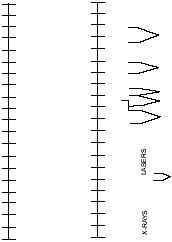Lasers can have varying effects on a person.
Effects on the eyes can range from inflammation of the
cornea to corneal burn. Effects on the skin can range
from accelerated skin aging to skin burn. If you use
lasers at your command, be sure to follow all safety
precautions for the class of laser in use and all
directions given to you by your command’s laser safety
officer.
For more information on the use of lasers, refer to
the Navy Occupational Safety and Health (NAVOSH)
Program Manual, OPNAVINST 5100.23, for shore
operations; and the NAVOSH Program Manual for
Forces Afloat, OPNAVINST 5100.19, for shipboard
operations.
Q6. What common household appliance is typically
used to illustrate the tissue damage that can be
done by harmful RF exposure?
TAG-OUT BILL
The tag-out bill is a system of documents used to
save lives and to prevent unnecessary damage to
equipment. It uses caution tags, danger tags,
3-7
No.
EDS Precautions
1
ALWAYS ground the workbenches where you will handle ESDS devices.
2
ALWAYS be sure that you are grounded.
3
ALWAYS check packaging and equipment technical manuals for ESD warnings and instructions.
4
ALWAYS ground the electrostatic unit package of an ESDS device or assembly before you open it.
5
ALWAYS minimize the handling of ESDS devices or assemblies.
6
ALWAYS avoid unnecessary physical movement.
7
ALWAYS hold the ESDS device or assembly through its electrostatic-free wrap, if possible, when you remove or
replace it in the equipment.
8
ALWAYS touch, with your bare skin, the surface on which an ESDS device or assembly rests for at least 1 second
before you pick it up.
9
ALWAYS avoid repairs that require soldering at the equipment level, if possible.
10
ALWAYS ground the leads of test equipment before you energize it and before you probe ESDS items.
11
NEVER permit ESDS devices or assemblies to come in contact with ungrounded materials.
12
Whenever you service ESDS devices, NEVER touch or handle materials that create static charges without
repeating the grounding action.
Table 3-6.—Electrostatic Discharge Precautions
}}
}
}
}
3 x 10
3 x 10
3 x 10
3 x 10
3 x 10
3 x 10
3 x 10
3 x 10
3 x 10
3 x 10
3 x 10
3 x 10
3 x 10
3 x 10
3 x 10
3 x 10
3 x 10
3 x 10
3 x 10
3 x 10
3 x 10
10
10
10
10
10
10
10
10
10
10
10
10
10
10
10
10
10
10
10
10
0
1
2
3
4
5
6
7
8
9
10
11
12
13
14
15
16
17
18
19
20
10
8
7
6
5
4
3
2
1
0
-1
-2
-3
-4
-5
-6
-7
-8
-9
-10
-11
-12
FREQUENCY
WAVELEGNTH
(HZ)
(M)
COMMERCIAL POWER (60 Hz)
TELEPHONE
AM BROADCAST (536.1505 kHz)
FM BROADCAST (88.106 Mhz)
TELEVISION BROADCAST
RADAR
INFRARED
VISIBLE LIGHT
ULTRAVIOLET
OPTICAL
RADIATION
1 Hz
60 Hz
1 Khz
1MHz
1 Ghz
1 Thz
3Mm
3km
3m
3 cm
3mm
3nm
3A deg
3 pm
}
MEDICAL X-RAYS
3100
FCf03002
Figure 3-2.—The electromagnetic spectrum.

